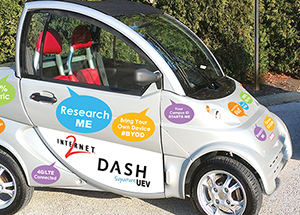Driving Electric Car Research
Pitt researchers have long had a drive to understand how things work. Now they have the opportunity to drive to understand how the Innova Dash University Electric Vehicle (UEV), a tiny electric car, works—and to find out how to make it work better.
researchers have long had a drive to understand how things work. Now they have the opportunity to drive to understand how the Innova Dash University Electric Vehicle (UEV), a tiny electric car, works—and to find out how to make it work better.
Pitt is one of four universities nationwide that is testing the two-seat car beginning in July. The endeavor is in collaboration with Internet2, a national consortium of research and education institutions looking to solve common technology challenges.
Pitt researchers are testing four UEVs and looking at how they could help reduce the campus’ carbon footprint by collecting massive amounts of data from the car’s various sensors. The yearlong project is also designed to raise awareness of the “Internet2 of Things,” a concept used to describe electronic communication between devices such as the electric cars and Pitt’s data-collection devices—independent of people.
Patricia Beeson, Pitt provost and senior vice chancellor, says that Pitt’s selection as a UEV tester speaks well of the University’s many different strengths.
“This is a unique opportunity to make Pitt’s research, sustainability, and technology strengths visible in a very accessible way,” she says. “Collaborative partnerships like this one effectively complement the University’s sustainability efforts, offering concrete examples of sustainable practices using technology and collecting large data sets that can prompt future research questions.”
Ervin Sejdic, assistant professor of electrical and computer engineering in Pitt’s Swanson School of Engineering, is leading the UEV effort at Pitt. He believes that one of the most significant areas of research will be “energy optimal routing.”
Say, for example, a person wants to drive a UEV from Pitt’s lower campus to high atop Cardiac Hill. Will the steepest route up drain the battery to such a degree that returning via the same route—and using the car’s regenerative braking system that recharges the battery by transferring power from the brakes to the battery—won’t be enough to offset the loss?
And what’s the best way to drive the car in general? What are the optimal situations in which to accelerate or brake? How powerfully or how softly should the ideal driver stomp on the accelerator?
The UEVs are being used by several entities at Pitt. Computing Services and Systems Development has one car, as does Parking, Transportation and Services. The Swanson School of Engineering has two.
Brian Stengel, a staff member in the office of the chief information officer at Computing Services and Systems Development, is the project manager/outreach coordinator for the UEV project. Marlin Mickle, Pitt professor emeritus of electrical and computer engineering, is serving as an advisor on the project.
Colorado State University, the University of Washington, and the University of Wisconsin are also testing the Innova Dash.
Other Stories From This Issue
On the Freedom Road

Follow a group of Pitt students on the Returning to the Roots of Civil Rights bus tour, a nine-day, 2,300-mile journey crisscrossing five states.
Day 1: The Awakening
Day 2: Deep Impressions
Day 3: Music, Montgomery, and More
Day 4: Looking Back, Looking Forward
Day 5: Learning to Remember
Day 6: The Mountaintop
Day 7: Slavery and Beyond
Day 8: Lessons to Bring Home
Day 9: Final Lessons

